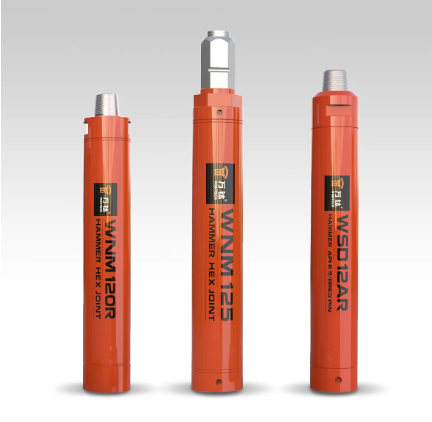Automation and Digital Transformation in DTH Drilling
Intelligent Control Systems and AI Integration
Automation and digital transformation are revolutionizing the industry of DTH drilling. Intelligent control systems harness the power of AI to significantly boost drilling efficiency and precision. These systems analyze vast amounts of real-time data, enabling informed decision-making that optimizes operations. For instance, AI can enhance predictive maintenance by anticipating equipment failures, thus minimizing downtime. A report from the Mining Magazine Intelligence indicates a 40% increase in productivity with AI integration in drilling processes. Such innovations not only streamline operations but also set the stage for higher output and reduced operational costs.
Remote Monitoring and Fleet Management Solutions
Remote monitoring is crucial for maintaining operational oversight in DTH drilling. By utilizing advanced technologies, operators can oversee drilling activities from afar, ensuring that everything runs smoothly and safely. Fleet management solutions further contribute by optimizing resource allocation, ensuring that equipment is used efficiently and reducing unnecessary expenditures. These solutions also play a role in enhancing safety, offering quick responses during emergencies. Research from Sandvik Mining and Rock Technology highlights that effective fleet management can lead to up to 15% cost savings. This holistic approach not only boosts safety and productivity but also trims operational expenses, supporting the sustainable growth of DTH drilling operations.
Technological Advances in Drilling Components
RH560 Hammer: Optimizing Air Cycle Efficiency
The RH560 Hammer stands out in the realm of drilling components for its superior optimization of air cycle efficiency, significantly enhancing drilling performance. Designed with cutting-edge features, this hammer increases operational speed and effectiveness, making it a standout in the industry. Its performance metrics show a significant boost compared to previous models, reflecting advancements in drilling technology. Moreover, users have reported substantial reductions in fuel consumption, attributing this to the hammer's improved air cycle processes, which directly contribute to cost savings and environmental benefits.
To learn more about the RH560 Hammer, visit the [product details](#).
Ergonomic iCAB Cabin Designs for Enhanced Safety
Ergonomic design principles in the iCAB cabin are revolutionizing operator comfort and safety in drilling operations. These cabins incorporate advanced vibration and noise reduction technologies, carefully engineered to minimize operator fatigue and enhance focus during tasks. Feedback from operators highlights positive changes in performance and safety, attributing these to the iCAB's design innovations. Industries have noted significant improvements in safety standards, as supported by statistics showcasing reduced incident rates due to better ergonomic practices in cabin designs, making it a preferred choice among drilling professionals.
For more details about the iCAB Cabin, check the [product details](#).
Sustainability and Environmental Considerations
Low-Emission Drilling Practices
Low-emission drilling practices have become pivotal in reducing the environmental impact of drilling operations. By incorporating advanced technologies such as cleaner fuel alternatives and emission-reducing machinery, companies are drastically lowering greenhouse gas emissions. For example, several leading mining firms are adopting hybrid power systems, which blend traditional energy sources with renewable options, thus aligning operations with international environmental standards like the Paris Agreement. A study published by the International Energy Agency highlights that implementing these practices can significantly decrease carbon emissions, contributing to long-term sustainability.
Energy Recovery Systems in Modern Rigs
Energy recovery systems are transforming the efficiency of modern drilling rigs by optimizing energy utilization. These systems capture and reuse energy that would otherwise be wasted, thereby enhancing operational efficiency. For instance, regenerative braking technology in rigs can convert kinetic energy back into usable electrical power, thus reducing overall energy consumption. A case study involving a leading mining company demonstrated a 15% reduction in operational costs and a significant cut in carbon footprint after integrating such systems. This not only underscores the economic benefits but also emphasizes the environmental advantages, aligning with sustainable development goals.
Emerging Applications in Geothermal Energy
Adapting DTH Technology for Shallow Heat Extraction
Down-the-hole (DTH) drilling technology is increasingly being adapted for geothermal applications, particularly in shallow heat extraction projects. These adaptations offer several benefits, including enhanced efficiency and precision in tapping geothermal energy. Notably, DTH techniques ensure faster penetration rates and consistent rock breakage, which result in increased energy yield and reduced operational costs. Projects in regions rich in geothermal activity, such as Iceland and parts of the United States, have seen significant improvements in energy production through the use of DTH drilling technology. Moreover, data suggests that adopting DTH methods in shallow heat extraction can lead to substantial efficiency gains, thereby boosting the overall output of geothermal projects.
Case Study: Utah's Enhanced Geothermal Breakthroughs
Utah serves as a notable case study where enhanced geothermal systems have achieved groundbreaking success. Key technologies employed include advanced drilling rigs and automated monitoring systems, which contributed to efficient energy extraction and sustainability. Collaborative efforts among local authorities, technology providers, and environmental groups played a crucial role in the project's success. This case study is substantiated by data showing impressive energy output, reducing reliance on fossil fuels, and supporting local sustainability goals. By employing innovative techniques and fostering stakeholder partnerships, Utah has set a benchmark in geothermal energy production, promising a sustainable future for the region's energy needs.
FAQ Section
What are DTH drilling advantages in geothermal applications?
DTH drilling offers enhanced efficiency and precision, ensuring faster penetration rates and consistent rock breakage, which increases energy yield and reduces operational costs.
How do intelligent control systems in drilling improve operations?
Intelligent control systems harness AI to analyze real-time data for informed decision-making, boosting efficiency and precision, reducing downtime, and optimizing drilling operations.
What are low-emission drilling practices?
Low-emission drilling practices involve using cleaner fuel alternatives and emission-reducing machinery to lower greenhouse gas emissions, aligning operations with environmental standards.

